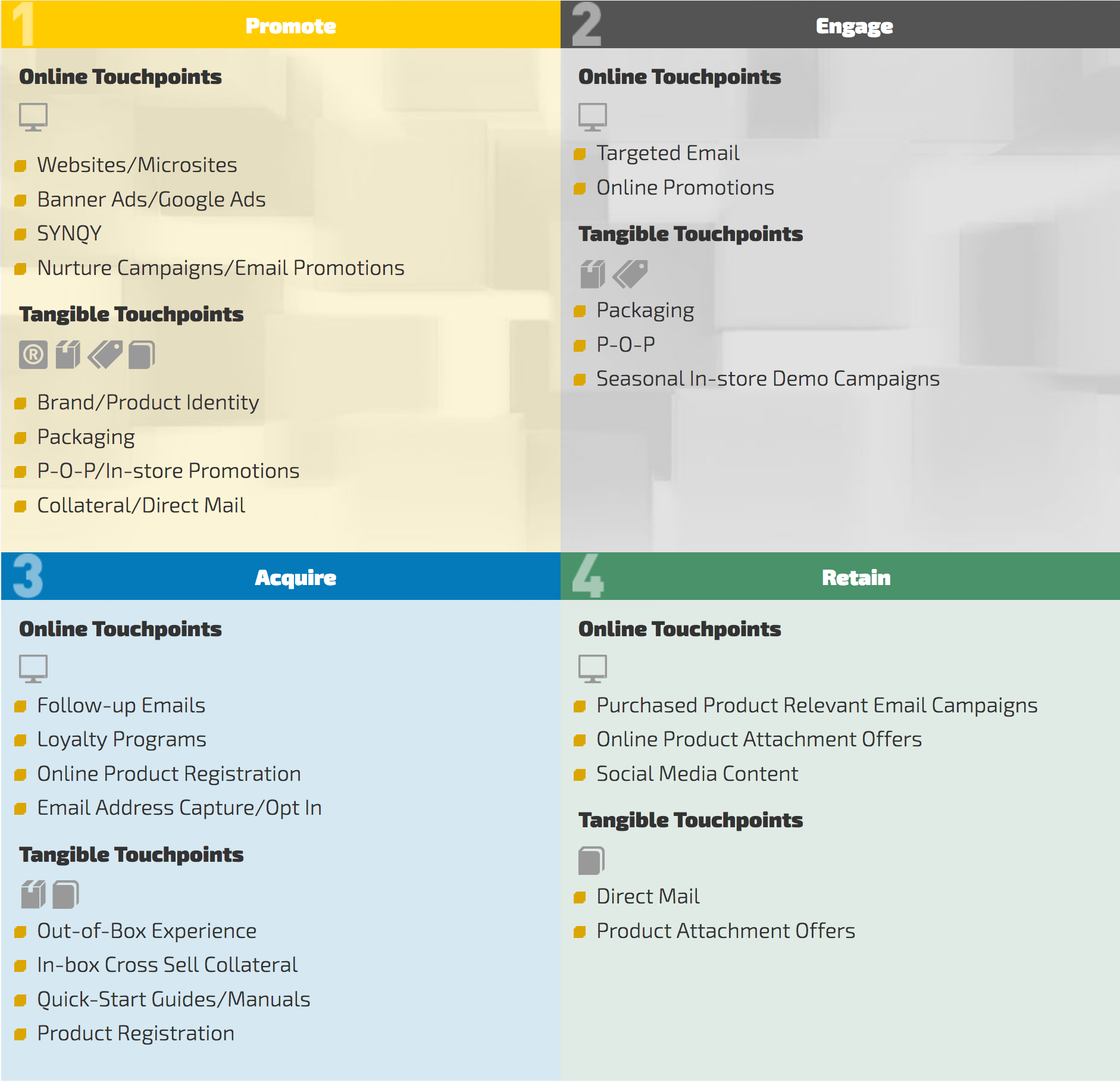The Manufacturer is often blamed for potholes that take place during the path-to-purchase. Each group responsible for bringing the product to market often function in silos with no common goal. Nowhere is this more obvious than in the consumer technology industry. The result is an inconsistent message that confuses the customer during the buying process. Identified below are the four steps outlining the physical and digital touchpoints a customer may encounter along the way.

All of these touchpoints should have a consistent message and branding to make the path-to-purchase a success. Unfortunately, this isn’t always the case. I have experienced each of these during my time working on the client side and agency side of retail marketing.
POTHOLE #1 Weak Branding: Product Design and Engineering
While a product is being engineered, there is also an industrial designer involved who designs the format and footprint that determines how a consumer will interact with the product. I have worked on launching products where the industrial designer designed the logo for the product and determined the font and placement. Industrial designers are creative but they shouldn’t be in charge of the branding of the product. Oftentimes marketers get involved too late and they need to work with a name or font that isn’t appropriate for the product. This starts the marketing of the product from a weak brand position and will hamper the path-to-purchase.
POTHOLE #2 Cluttered Packaging: Product Management and Product Marketing
These two departments have a worms eye view of the product. They have an in depth knowledge of the market, the competition and the positioning they think is appropriate for the product. They also use a lot of words and they often think every feature needs to be communicated on marketing materials. One shared responsibility they have is product packaging. These groups often don’t have the expertise to guide a team to design the package. When providing the information to the marketing team or directly to the designer, they provide too much detail and have a difficult time targeting the message. The result can be a box that is too cluttered, has no hierarchy of messaging and contains a wordy positioning statement and supporting bullet points. Packaging that doesn’t communicate the benefit of the product to the customer may mean they will choose a competitor’s product which communicates to them more effectively.
POTHOLE #3 Bad Out-of-Box Experience: Operations and Purchasing
These groups are tasked with containing costs of the product packaging. Sacrifices need to be made to meet the per unit cost of the packaging and its contents. A customer engages with the brand through the packaging so if this experience is negative, it is a poor reflection on the brand. If the quality of the packaging doesn’t match the perceived value of the product, this can effect the perception of the brand. The out-of-box experience includes the set up materials which are sometimes directed by operations. If the materials are inconsistent and hard to follow this experience may cause a customer to give a negative review on the product. In addition, they won’t recommend the product or become a brand advocate.
POTHOLE # 4 Inconsistent Messaging: Marketing
Often times, in consumer high-tech manufacturing companies, the packaging artwork has already been handed off to be printed well before the marketing teams become fully engaged. The messaging on the package and it’s in-store brand perception has already been created so marketing teams must work with what has already been developed OR they may ignore all of the previous work and start from scratch. This includes advertising, PR, merchandising and channel marketing. If all of marketing isn’t under the guidance of one strong VP or Director, the messaging can be inconsistent across all different outlets. This continues the customer’s confusion along the path-to-purchase and weakens the message of the brand.
POTHOLE #5 Poor Online Experience: IT Department
Customers often start their product research online so this is their first exposure to the brand. A company’s website is often managed by the “internet group” or “IT department”. They are responsible for updating content and managing the maintenance. Sometimes marketing has a key role in providing content and sometimes it doesn’t. If the company’s website has a rigid content management system, adding content is difficult and has little flexibility. Even if there is great content available, the wait time to get it uploaded can be long and won’t benefit the launch of a new product. This first impression sets the stage for the path-to-purchase. If the product doesn’t have a consistent brand message, the customer could abandon the online or in store purchase.
Below are more articles about the path-to-purchase:
7 Ways to Win Customers on their Path-to-Purchase
Off the Beaten Path to Purchase
New Consumer Path to Purchase

As a consumer, there are many times I have passed up a product that I was interested in because the website was terrible. If the website is dated, cluttered or hard to navigate, I get frustrated and leave. My husband is thankful for my poor online shopping experiences, as it keeps money in the bank.